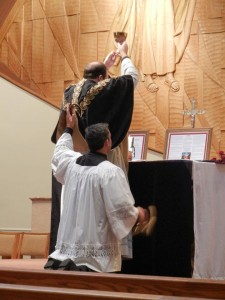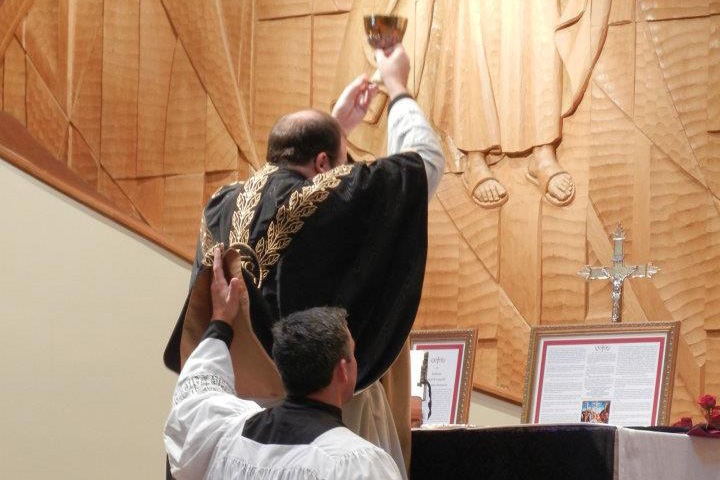 Perhaps as a concluding post on funeral masses, this is my third post on the subject this week (omni trinum perfectum – all things are perfect in three), I would like to re-post an article I wrote over a year ago.
Perhaps as a concluding post on funeral masses, this is my third post on the subject this week (omni trinum perfectum – all things are perfect in three), I would like to re-post an article I wrote over a year ago.
Many of the comments these past days mentioned the Traditional Latin Requiem Mass, which I have been privileged to celebrate many times in my 25 years. It is a beautiful and gentle liturgy, so consoling and yet also sober and mindful that someone has died and that we ought to pray.
And while I do not say that everyone must like this form, I also think the Requiem Mass has been unfairly panned, especially by some (not all) older clergy. What follows is my answer to those critiques in hopes of establishing greater understanding and mutual respect:
_______________
When I was in seminary back in the mid 1980s I was informed by some of my Seminary teachers, that the old funeral masses were a very dark affair. Black vestments and somber prayers all focused on judgment were supposedly an “extreme” that had to give way. Never mind that the new Mass permitted black or purple vestments, the point was that we were not to use black vestments and were to wholly avoid any “negative” themes like judgment, purgatory or (the absolutely forbidden) hell.
Discussions about funeral masses were common in my seminary years since the revised rite of funerals was coming out at that time and, just like the new translation we have recently inaugurated, there were many vigorous discussion about the funeral rite of 1970 and how the one coming out in 1987 (in think) was either an improvement or a “step backward.”
By the time I was ordained in the late 1980s it was once again permitted to offer the traditional Latin Mass, and though some argued that this didn’t include funerals, we routinely celebrated them here in DC as early as 1987. I have been privileged to celebrate at couple of these traditional Latin funeral masses per year, by request all 24+ years of my priestly life. (The photo at upper right is me celebrating one last November in one of our Maryland Parishes).
And I must say, find these funerals (called Requiem Masses) anything but dark. Let me explain.
To begin, though, early in my priesthood I had little of no memory of the older funeral rites. I was, in those days before the current motu proprio, one of the few priests permitted by the diocese to celebrate the TLM. Thus, as I began my study of the old Requiem Mass when requested to do one in 1989 and I expected, based on my training to find and read dreary and depressing prayers.
I noted first that the “dreaded and dark affair,” described so by some, was called a “Requiem Mass.” Hmm…. in other words, a “Mass of Rest.” That doesn’t shout of foreboding things, seems rather peaceful actually, and far more comforting that the more usual modern word, “funeral.” Indeed the opening words of the dreaded Requiem Mass read (translated) Rest Eternal grant unto them O Lord and may perpetual light shine on them. Hmm… I thought, we’re not off to such a terrible start.
Greeting the Body at the door of the Church, though less baptismal in focus, contains these beautiful wishes:
Come to his assistance, ye Saints of God, come forth to meet him, ye Angels of the Lord….receiving his soul, offer it in the sight of the Most High…..May Christ receive thee who has called thee….and may the Angels lead thee into Abraham’s bosom.
The opening prayer too, appeals to God’s mercy, though (heaven forfend), it does mention Hell:
O God, whose property is ever to have mercy and to spare, we humbly entreat Thee on behalf of the soul of Thy servant whom Thou hast bidden to pass out of this world: that Thou wouldst not deliver him into the hands of the enemy nor forget him for ever, but command him to be taken up by the holy Angels, and to be borne to our home in paradise, that as he had put his faith and hope in Thee he may not undergo the pains of hell but may possess everlasting joys.
As we have well discussed here, to many modern ears the very mention of Hell is “dark,” but the whole prayer is premised on God to whom it is proper to show mercy and to spare. Hence it is a prayer uttered in confident expectation that through grace and mercy we stand a chance. And, as for that little mention of “Hell,”….isn’t that….like….in the Bible or something? (Well again we have well discussed here that Hell is both biblical and reasonable).
So, in my study I still had not found where we had gone to dark, negative places, as I had been taught to expect.
The readings also surprised me. The Epistle is from First Thessalonians 4: Brethren, we would not have you ignorant concerning those who sleep, lest you be like the others who have no hope. Then comes the great teaching on the day of resurrection and the conclusion: Therefore console One another with these words. The Gospel too is of Jesus’ dialogue with Martha in John 11: Your brother will rise…I AM the resurrection and the life, whoever believes in me, even if he dies, will live. Beautiful and consoling, really.
There is of course the Dies Irae in between these two readings. I recall an older priest many years ago when the subject came up proclaiming exultantly: “Thank God we got rid of that dreadful thing.” It does truly begin on an ominous note: Day of wrath and doom impending, heaven an earth in ashes ending….Oh what fear man’s bosom rendenth, when from heaven the judge decendeth, on whose sentence all dependeth. True, these are dark lines, but they are biblical lines, almost direct quotes. Yet the same Dies Irae contains some of the most hopeful and tender lines in all Christian writing:
Faint and weary thou hast sought me:
On the cross of suffering bought me:
Shall such grace be vainly bought me?
Through the sinful Mary shriven,
Through the dying thief forgiven,
Thou to me a hope has given.
Loving Jesus Lord most blest,
Grant to them eternal rest.
Amen.
The darker lines thus highlight the lightsome ones. So even the Dies Irae is not all that bad. It is a well balanced description of our sinful condition, and of God’s mercy accessed through repentance. I have written more of the Dies Irae here: Sing the Dies Irae at my Funeral
I obviously cannot reproduce the whole Requiem Mass here but consider just a few other highlights of the hopeful and gentle themes that are struck in the prayers
- From the Preface: …through Christ our Lord, in whom the hope of blessed resurrection has shone on us, so that those who are saddened by the certainty of dying may be consoled by the promise of a future deathless life. For to thy faithful people, Oh Lord, life is changed, not taken away, and when the home of this earthly sojourn is dissolved, an eternal dwelling place is being prepared in the heavens.
- From the Communion verse: May light eternal shine on them O Lord, with your saints forever. For you are kind. (Quia pius es)
- Finally, if there is any “darkness” at all in the old Requiem Mass, it is more likely due to the fact that we have departed a great degree in modern times from the notion that, after we die, we are certainly judged. And this judgement is a moment of honesty before God. Surely all of us will need much in the way of grace and mercy. The prayers of the older Requiem give honest acknowledgment of that, but draw heavily on Biblical themes. In the end, these prayerful reflections are always couched on the fact that God is rich in mercy. One of the final prayers, at the commendation of the soul shows this balance. Standing before the casket the priest says:
- Enter not into judgment with Thy servant, O Lord; for, save Thou grant him forgiveness of all his sins, no man shall be justified in Thy sight. Wherefore suffer not, we beseech Thee, the sentence Thou pronounce in judgment upon one whom the faithful prayer of Christian people commends to Thee, to be a doom which shall crush him utterly. Rather sustain him by Thy gracious favor, that he may escape Thine avenging justice who, in his lifetime, was signed with the seal of the holy Trinity. Who livest and reignest world without end. Amen.
Disclaimers – Most of you know that I love the Traditional Latin Mass, especially in its sung forms. However, I also like the Ordinary Form of the Mass and it is the way I celebrate 99% of my masses.
The New Funeral Mass is not intrinsically flawed. If there are imbalances in modern funerals it is not wholly the fault of the liturgy. Rather, the imbalance of our culture and the clergy’s emphases seem more at work. (As we discussed these past two days).
For the record, black vestments can still be worn in the newer rites, as well as purple. There is nothing to prevent the clergy from preaching clearly on judgement and purgation, as well Heaven. I surely do (as we discussed yesterday), and also issue a pretty sober “come to Jesus” talk in the sermon, since so many who are at funerals are not practicing their faith.
Thus, balance can be had in the newer rites. This post is simply meant to express that a pronouncement of the Requiem Mass as dark and somber, which I was regularly subjected to in my training, is simplistic.
The reality I have come to experience in over 24 years of celebrating Requiem Masses is that they are both gentle and hopeful, sober about judgement but well steeped in mercy and confidence in God’s loving kindness.
Here’s the “In paradisum” from the Faure Requiem:

